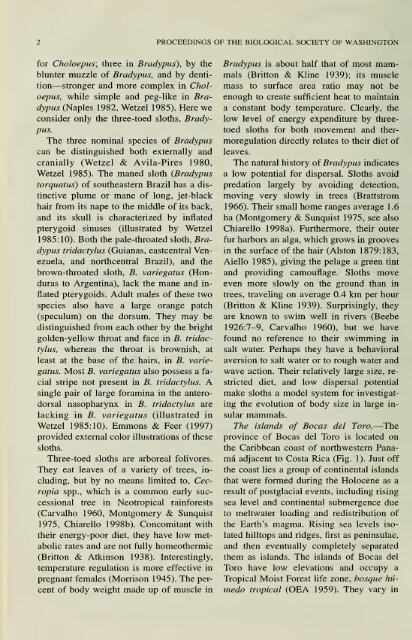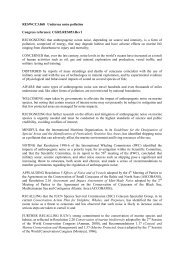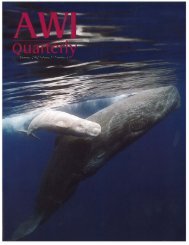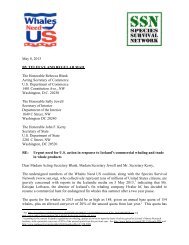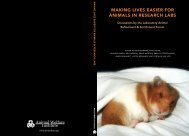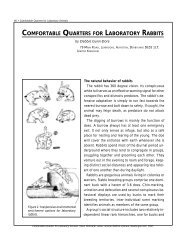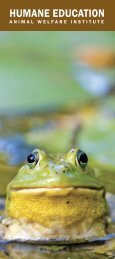EMERGENCY PETITION TO LIST THE PYGMY THREE-TOED SLOTH
EMERGENCY PETITION TO LIST THE PYGMY THREE-TOED SLOTH
EMERGENCY PETITION TO LIST THE PYGMY THREE-TOED SLOTH
Create successful ePaper yourself
Turn your PDF publications into a flip-book with our unique Google optimized e-Paper software.
PROCEEDINGS OF <strong>THE</strong> BIOLOGICAL SOCIETY OF WASHING<strong>TO</strong>Nfor Choloepus; three in Bradypus), by theblunter muzzle of Bradypus, and by dentition—strongerand more complex in Choloepus,while simple and peg-like in Bradypus(Naples 1982, Wetzel 1985). Here weconsider only the three-toed sloths, Bradypus.The three nominal species of Bradypuscan be distinguished both externally andcranially (Wetzel & Avila-Pires 1980,Wetzel 1985). The maned sloth (Bradypustorquatus) of southeastern Brazil has a distinctiveplume or mane of long, jet-blackhair from its nape to the middle of its back,and its skull is characterized by inflatedpterygoid sinuses (illustrated by Wetzel1985:10). Both the pale-throated sloth, Bradypustridactylus (Guianas, eastcentral Venezuela,and northcentral Brazil), and thebrown-throated sloth, B. variegatus (Hondurasto Argentina), lack the mane and inflatedpterygoids. Adult males of these twospecies also have a large orange patch(speculum) on the dorsum. They may bedistinguished from each other by the brightgolden-yellow throat and face in B. tridactylus,whereas the throat is brownish, atleast at the base of the hairs, in B. variegatus.Most B. variegatus also possess a facialstripe not present in B. tridactylus. Asingle pair of large foramina in the anterodorsalnasopharynx in B. tridactylus arelacking in B. variegatus (illustrated inWetzel 1985:10). Emmons & Peer (1997)provided external color illustrations of thesesloths.Three-toed sloths are arboreal folivores.They eat leaves of a variety of trees, including,but by no means limited to,Cecropiaspp., which is a common early successionaltree in Neotropical rainforests(Carvalho 1960, Montgomery & Sunquist1975, Chiarello 1998b). Concomitant withtheir energy-poor diet, they have low metabolicrates and are not fully homeothermic(Britton & Atkinson 1938). Interestingly,temperature regulation ismore effective inpregnant females (Morrison 1945). The percentof body weight made up of muscle inBradypus is about half that of most mammals(Britton & Kline 1939); its musclemass to surface area ratio may not beenough to create sufficient heat to maintaina constant body temperature. Clearly, thelow level of energy expenditure by threetoedsloths for both movement and thermoregulationdirectly relates to their diet ofleaves.The natural history of Bradypus indicatesa low potential for dispersal.Sloths avoidpredation largely by avoiding detection,moving very slowly in trees (Brattstrom1966). Their small home ranges average 1.6ha (Montgomery & Sunquist 1975, see alsoChiarello 1998a). Furthermore, their outerfur harbors an alga, which grows in groovesin the surface of the hair (Alston 1879:183,Aiello 1985), giving the pelage a green tintand providing camouflage. Sloths moveeven more slowly on the ground than intrees, traveling on average 0.4 km per hour(Britton & Kline 1939). Surprisingly, theyare known to swim well in rivers (Beebe1926:7-9, Carvalho 1960), but we havefound no reference to their swimming insalt water. Perhaps they have a behavioralaversion to salt water or to rough water andwave action. Their relatively large size, restricteddiet, and low dispersal potentialmake sloths a model system for investigatingthe evolution of body size in large insularmammals.The islands of Bocas del Toro.—Theprovince of Bocas del Toro is located onthe Caribbean coast of northwestern Panamaadjacent to Costa Rica (Fig. 1). Just offthe coast lies a group of continental islandsthat were formed during the Holocene as aresult of postglacial events, including risingsea level and continental submergence duetomeltwater loading and redistribution ofthe Earth's magma. Rising sea levels isolatedhilltops and ridges, first as peninsulae,and then eventually completely sepaiatedthem as islands. The islands of Bocas delToro have low elevations and occupy aTropical Moist Forest life zone, bosque hiimedotropical (OEA 1959). They vary in


